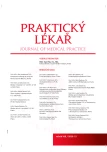Vascular Ehlers-Danlos syndrome (Sack-Barabas syndrome) –
multiorganomultivascular disease
Authors:
P. Gavornik 1,2; A. Dukát 1,3; Ľ. Gašpar 1,4; G. Gubo 1,5; N. Gajarová 1,6
Authors‘ workplace:
Angiologická sekcia Slovenskej lekárskej komory, Bratislava, Slovenská republika
1; Lekárska fakulta Univerzity Komenského, Bratislava, Slovenská republika
2; Ministerstvo zdravotníctva Slovenskej republiky, Bratislava, Slovenská republika
3; Univerzita Cyrila a Metoda v Trnave, Fakulta zdravotníckych vied v Piešťanoch, Slovenská republika
4; The Barking Medical Group Practice, 130 Upney Ln, Barking, IG11 9LT, London, United Kingdom
5; I. chirurgická klinika LF UK a UNB, Bratislava, Slovenská republika
6
Published in:
Prakt. Lék. 2020; 100(5): 215-220
Category:
Reviews
Overview
Ehlers-Danlos syndromes (EDS) are a group of rare connective tissue disorders that can be inherited and are varied both in how they affect the body and in their genetic causes. They are generally characterized by joint hypermobility, skin hyperextensibility, and tissue fragility. Ehlers-Danlos syndromes are currently classified in a system of thirteen subtypes. Each EDS subtype has a set of clinical criteria that help guide diagnosis. Vascular Ehlers-Danlos syndrome (VEDS; EDS subtype 4; EDS IV; Sack-Barabas syndrome) is rare genetic connective tissue disorder of blood-vessels typically characterized by the association of unexpected vascular and organovascular fragility (arterial/ microvascular/ bowel/ gravid uterine rupture) with inconstant physical features as thin, translucent skin, easy bruising and acrogeric traits.
Keywords:
Vascular Ehlers-Danlos syndrome (Sack-Barabas syndrome) – angiology/vascular medicine – multiorganomultivascular disease – dissection – aneurysm – rupture – haemorrhage – ischemia
Sources
1. Busch A, Suellner J, Anger F, et al. Critical care of kyphoscoliotic type Ehlers-Danlos syndrome with recurrent vascular emergencies. Vasa 2014; 43(3): 216–221.
2. Byers PH, Belmont J, Black J, et al. Diagnosis, natural history, and management in vascular Ehlers-Danlos syndrome. Am J Med Genet Semin Med Genet 2017; 175(1): 40–47.
3. Casana R, Nano G, Dalainas I, Tealdi DG. Endovascular treatment of hepatic artery aneurysm in a patient with Ehlers-Danlos syndrome. Case report. Int Angiol 2004; 23(3): 291–295.
4. Gavorník P, Dukát A, Gašpar Ľ, a kol. Erektilná dysfunkcia ako prvý znak systémových cievnych chorôb a organovaskulárnych artériových ischemických chorôb. Odporúčania a výzva Angiologickej sekcie Slovenskej lekárskej komory. Vnitř. Lék. 2015; 61(7–8): 660–669.
5. Gavorník P, Dukát A, Gašpar Ľ, a kol. Manažment hypertenzikov s končatinovocievnou artériovou chorobou. Kardiol Rev Int Med 2018; 20(2): 148–154.
6. Gavorník P, Dukát A, Gašpar Ľ, a kol. Aortové choroby – Odporúčania Angiologickej sekcie Slovenskej lekárskej komory pre klasifikáciu, diagnózu a princípy manažmentu chorôb aorty (AS SLK 2014). Ateroskleróza 2014; 18(3–4): 636–645.
7. Gavornik P, Dukát A, Gašpar Ľ, a kol. Mezenteriointestinokolonovaskulárna artériová ischemická choroba. Odporúčania Sekcie angiológov Slovenskej lekárskej komory (2013). Vnitř. Lék. 2014; 60(3): 239–248.
8. Gavorník P, Dukát A, Gašpar Ľ. Akútne a chronické aortové choroby hrudníkovej a brušnej aorty u dospelých. Odporúčania Angiologickej sekcie Slovenskej lekárskej komory pre klasifikáciu a diagnózu chorôb aorty (AS SLK, 2014). Vnitř. Lék. 2015; 61(1): 72–80.
9. Gavorník P. Angiológia 1 pre všeobecných praktických lekárov. Flebológia. Bratislava: Raabe 2013.
10. Gavorník P. Angiológia 2 pre všeobecných praktických lekárov. Arteriológia. Bratislava: Raabe 2014.
11. Gavorník P. Syndróm vénovej panvovej kongescie v klinickej praxi z pohľadu angiológa-internistu. Via pract 2019; 16(5): 196–199.
12. Grundtner P, Assadian A, Senekowitsch C, et al. History of a patients with Sack-Barabas Syndrome (Ehlers-Danlos Type IV) – 16 years of recurrent life-extending open and endovascular surgery. Eur J Vasc Endovasc Surg 2005; 9(5): 107–110.
13. Krajčovič J, Janík M, Straka Ľ, a kol. Ehlersov-Danlosov syndróm IV. typu ako príčina náhleho úmrtia 17-ročného chlapca: kazuistika a literárny prehľad. Pediatria (Bratislava) 2012; 7(6): 286–290.
14. Madaric J, Vulev I, Bartunek J, et al. Frequency of abdominal aortic aneurysm in patients > 60 years of age with coronary artery disease. Am J Cardiol 2005; 96(9): 1214–1216.
15. Malfait F, Francomano C, Byers PH, et al. The 2017 International Classification of the Ehlers-Danlos Syndromes. Am J Med Genet Semin Med Genet 2017; 175(1): 8–26.
16. Musumeci A, Minervini MI, Cintorino D, et al. Postoperative hepatic artery aneurysms development and remodeling in Ehlers-Danlos syndrome type IV. Case report. Int Angiol 2008; 27(2): 166–169.
17. The Ehlers-Danlos Society. 2017 EDS International Classification. Am J Med Genet Semin Med Genet 2017; 175(1): 1–245
Labels
General practitioner for children and adolescents General practitioner for adultsArticle was published in
General Practitioner

2020 Issue 5
- What Effect Can Be Expected from Limosilactobacillus reuteri in Mucositis and Peri-Implantitis?
- Metamizole vs. Tramadol in Postoperative Analgesia
- Memantine in Dementia Therapy – Current Findings and Possible Future Applications
- Memantine Eases Daily Life for Patients and Caregivers
Most read in this issue
- Electronic sick notes
- Assessment of preoperative fear in patients before elective surgery
- Possibilities of stability evaluation in clinical practice in patients at risk of falls Falls are a serious global public
-
Vascular Ehlers-Danlos syndrome (Sack-Barabas syndrome) –
multiorganomultivascular disease
